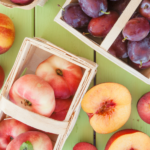The Secrets of Sweet Summer Melons
Summer is here, and that means it’s melon season! There’s nothing quite like biting into a juicy, sweet melon on a hot summer day. But biting into a disappointing melon – one that’s too hard, too mealy, or too bland – can be a real letdown. We can help! Here are our top tips for selecting, storing and using your melons to the fullest this summer.
What Makes A Sweet, Juicy Melon?
Understanding the needs of melons is helpful for selecting the tastiest ones. Sunshine and consistent watering are key for developing sweetness. Just as important is picking time. Melons picked too early may be hard and lack sweetness, while overripe ones can become soft and mushy. Cantaloupe and honeydew offer a little more flexibility as they will continue to ripen off the vine, while watermelons do not. Finally, storage temperature can impact the texture of melons. Extended cold temperatures can lead melons to lose flavour, colour and become mealy or even mushy.
With this in mind, here are our top tips to help you choose the best melons:
Stay Seasonal: Melons reach peak sweetness during their natural growing season, typically early summer to fall. Opting for melons during this time frame increases your chances of melon magic.
Seeded vs. Seedless: The debate rages on! Some people believe seeded melons have a more intense flavor, while others prefer the convenience of seedless varieties. We say, choose whichever you’ll enjoy the most.
Mini, Regular or Jumbo: Size doesn’t guarantee sweetness. Use the same criteria when choosing different varieties of watermelons.
Ripeness: Use these tips to judge the ripeness of a melon:
- Hollow Sound (Watermelons) – Use your knuckles to knock on the middle sides of watermelon and listen for a low pitch sound that resembles a knock on the door. A dull thud sound indicates the melon has not fully developed.
- Field Spot (Watermelons) – A creamy yellow (not white) field spot indicates ripeness.
- Netting (Cantaloupes) – Thick, well-defined netting on the skin is a sign of ripeness. Less developed netting is a sign of immature fruit.
- Colour – Look for vibrant, uniform colouration. Watermelons should have a consistent green colour with lighter stripes, while cantaloupes and honeydews should have a consistent hue without green undertones.
- Aroma (Cantaloupes and Honeydews) – A sweet, fruity aroma at the stem end indicates ripeness.
- Weight – Ripe melons feel heavy for their size due to high water content.
For more ideas see our A-Z storage guide for cantaloupe, honeydew and watermelon.
Storing Melons at Home
The ideal temperature for storing whole melons is 10°C (50°F) – warmer than fridge temperature but cooler than room temperature. So how can melon lovers store their melons at home? First, remember to Choose What You’ll Use and only buy melons that you’ll use within a week. All melons can be stored at room temperature for that time.
Once cut, store melon pieces in airtight containers to prevent them from drying out and absorbing odours. Cut melons are best eaten within 3-4 days.
Freezing is another tasty option for melons. Their high water content means they won’t hold their shape when thawed, but they make tasty ice cubes, frozen snacks or additions to smoothies.
Extra Bites – Ideas for Extra Melons
Here are some creative ways to prevent melon waste. Even the rind can be used!
- Rind Pickles: Pickle leftover watermelon rinds for a tangy and refreshing condiment. Peel the outer part of the rind and use the white part in place of strawberries in this fruity pickle recipe.
- Fruity Bowls: Use the outer shell of melons as a punch bowl or as a bowl for fruit salad.
- Stir Fried Rinds: Peel the outer most part of a melon and cut the firm rind in strips for stir fries.
- Smoothies: Add leftover melon and/or rinds (peel the most outer layer) to your smoothies for a burst of sweetness and hydration.
- Frozen Treats: Freeze leftover melon chunks for a healthy and delicious frozen snack.
- Melon Granita: Mix pureed melon with heavy syrup to make flavourful shaved ice, perfect for dessert or for homemade slushies.
- Melon Salad: Combine melon cubes with cucumber, feta, and mint for a refreshing salad.
- Salsa: Dice melons and mix with red onion, jalapeno, lime juice, and cilantro for a zesty salsa.
- Melon Gazpacho: Blend watermelon with cucumber, tomato, and herbs for a chilled and flavorful soup.
We’d love to see your melon creations! Share a picture or comment on our Instagram @lovefoodhatewasteca. Let’s enjoy the taste of summer and minimize food waste together!


